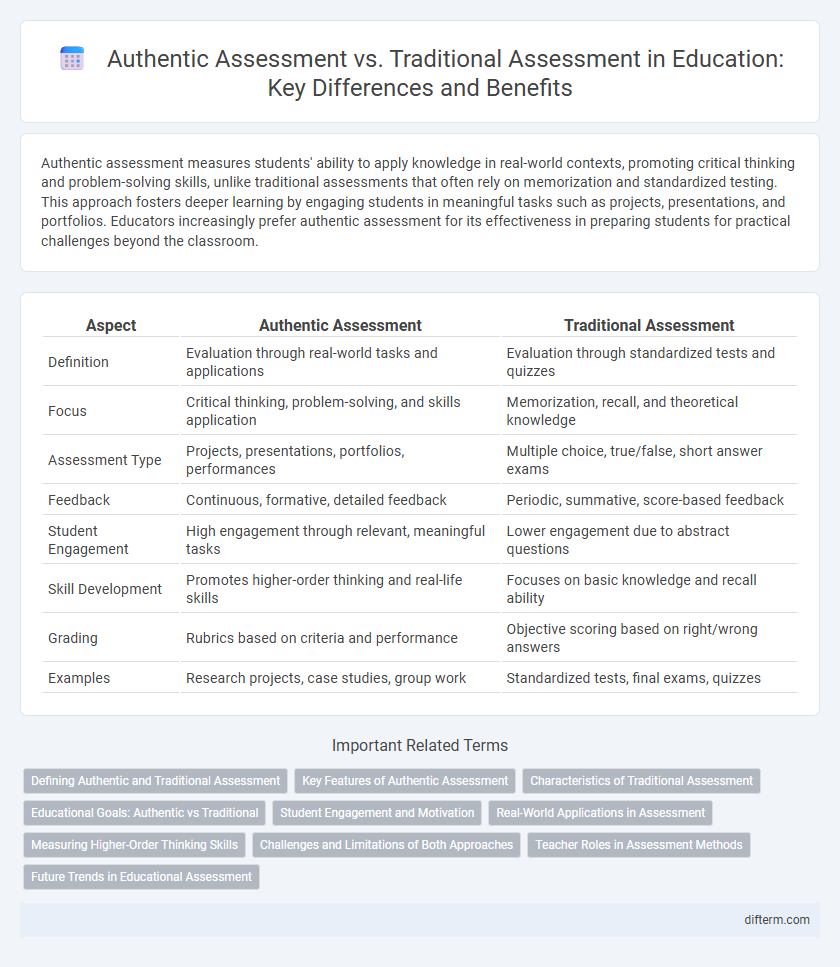Authentic assessment measures students' ability to apply knowledge in real-world contexts, promoting critical thinking and problem-solving skills, unlike traditional assessments that often rely on memorization and standardized testing. This approach fosters deeper learning by engaging students in meaningful tasks such as projects, presentations, and portfolios. Educators increasingly prefer authentic assessment for its effectiveness in preparing students for practical challenges beyond the classroom.
Table of Comparison
| Aspect | Authentic Assessment | Traditional Assessment |
|---|---|---|
| Definition | Evaluation through real-world tasks and applications | Evaluation through standardized tests and quizzes |
| Focus | Critical thinking, problem-solving, and skills application | Memorization, recall, and theoretical knowledge |
| Assessment Type | Projects, presentations, portfolios, performances | Multiple choice, true/false, short answer exams |
| Feedback | Continuous, formative, detailed feedback | Periodic, summative, score-based feedback |
| Student Engagement | High engagement through relevant, meaningful tasks | Lower engagement due to abstract questions |
| Skill Development | Promotes higher-order thinking and real-life skills | Focuses on basic knowledge and recall ability |
| Grading | Rubrics based on criteria and performance | Objective scoring based on right/wrong answers |
| Examples | Research projects, case studies, group work | Standardized tests, final exams, quizzes |
Defining Authentic and Traditional Assessment
Authentic assessment evaluates students' abilities through real-world tasks that require critical thinking, problem-solving, and application of knowledge, reflecting practical skills relevant to their field. Traditional assessment relies on standardized tests, quizzes, and exams that measure rote memorization and recall of discrete facts under controlled conditions. While authentic assessment emphasizes contextual learning and performance, traditional assessment prioritizes uniformity and quantifiable scores.
Key Features of Authentic Assessment
Authentic assessment emphasizes real-world tasks that require critical thinking, problem-solving, and application of knowledge, contrasting with the memorization focus often found in traditional assessments. It includes performance-based evaluations, portfolios, and self-reflections that provide a comprehensive understanding of a student's abilities. This approach promotes deeper learning by connecting academic content to practical, meaningful contexts.
Characteristics of Traditional Assessment
Traditional assessment is characterized by standardized testing methods such as multiple-choice, true/false, and short answer questions, which primarily measure rote memorization and recall. It relies on objective grading with predetermined correct answers, often emphasizing summative evaluation over formative feedback. This approach tends to prioritize quantifiable data and uniform administration, limiting the scope for assessing higher-order thinking skills or real-world application.
Educational Goals: Authentic vs Traditional
Authentic assessment emphasizes real-world skills and critical thinking aligned with educational goals, promoting deeper understanding and the application of knowledge in practical contexts. Traditional assessment often prioritizes rote memorization and standardized testing, focusing on content recall rather than problem-solving abilities. This shift towards authentic evaluation supports competency-based education and prepares students for complex challenges beyond the classroom.
Student Engagement and Motivation
Authentic assessment promotes higher student engagement and motivation by involving real-world tasks that require critical thinking and problem-solving skills. Unlike traditional assessment, which often focuses on rote memorization and standardized testing, authentic assessment encourages active participation and personal relevance. This approach leads to deeper learning experiences and sustained intrinsic motivation among students.
Real-World Applications in Assessment
Authentic assessment focuses on evaluating students through tasks that simulate real-world challenges, enhancing practical skill application and critical thinking. Traditional assessment often relies on standardized tests that emphasize memorization and recall rather than contextual understanding. Incorporating authentic assessment in education better prepares students for workplace demands by aligning evaluation methods with real-life scenarios and problem-solving situations.
Measuring Higher-Order Thinking Skills
Authentic assessment evaluates students' abilities to apply critical thinking, problem-solving, and creativity in real-world scenarios, effectively measuring higher-order thinking skills beyond rote memorization. Traditional assessments often focus on recall and lower-level cognitive skills through standardized tests and multiple-choice questions. By emphasizing performance tasks, portfolios, and projects, authentic assessments provide a more comprehensive understanding of students' analytical and evaluative capabilities.
Challenges and Limitations of Both Approaches
Authentic assessment faces challenges such as time-consuming design and grading processes, as well as subjectivity in evaluation that can affect reliability and consistency. Traditional assessment struggles with limitations like promoting rote memorization, lacking practical application of skills, and often failing to measure higher-order thinking effectively. Both approaches require careful implementation to balance fairness, validity, and the diverse learning needs of students.
Teacher Roles in Assessment Methods
Teachers act as facilitators and evaluators in authentic assessment by designing real-world tasks that measure critical thinking and problem-solving skills, contrasting with traditional assessment's focus on standardized tests and rote memorization. In authentic assessment, educators provide formative feedback that guides student learning and adapts instruction to individual needs, whereas traditional assessment often emphasizes summative evaluation with limited feedback. This shift enhances teacher roles from mere graders to active participants in promoting deeper understanding and skill application.
Future Trends in Educational Assessment
Future trends in educational assessment emphasize authentic assessment methods that engage students in real-world tasks, promoting deeper learning and critical thinking skills. These assessments leverage technology to provide adaptive, formative feedback, contrasting with traditional standardized tests that primarily measure rote memorization. Educators are increasingly adopting performance-based and portfolio assessments to capture a holistic view of student abilities, aligning evaluation with 21st-century skills and workplace competencies.
authentic assessment vs traditional assessment Infographic

 difterm.com
difterm.com